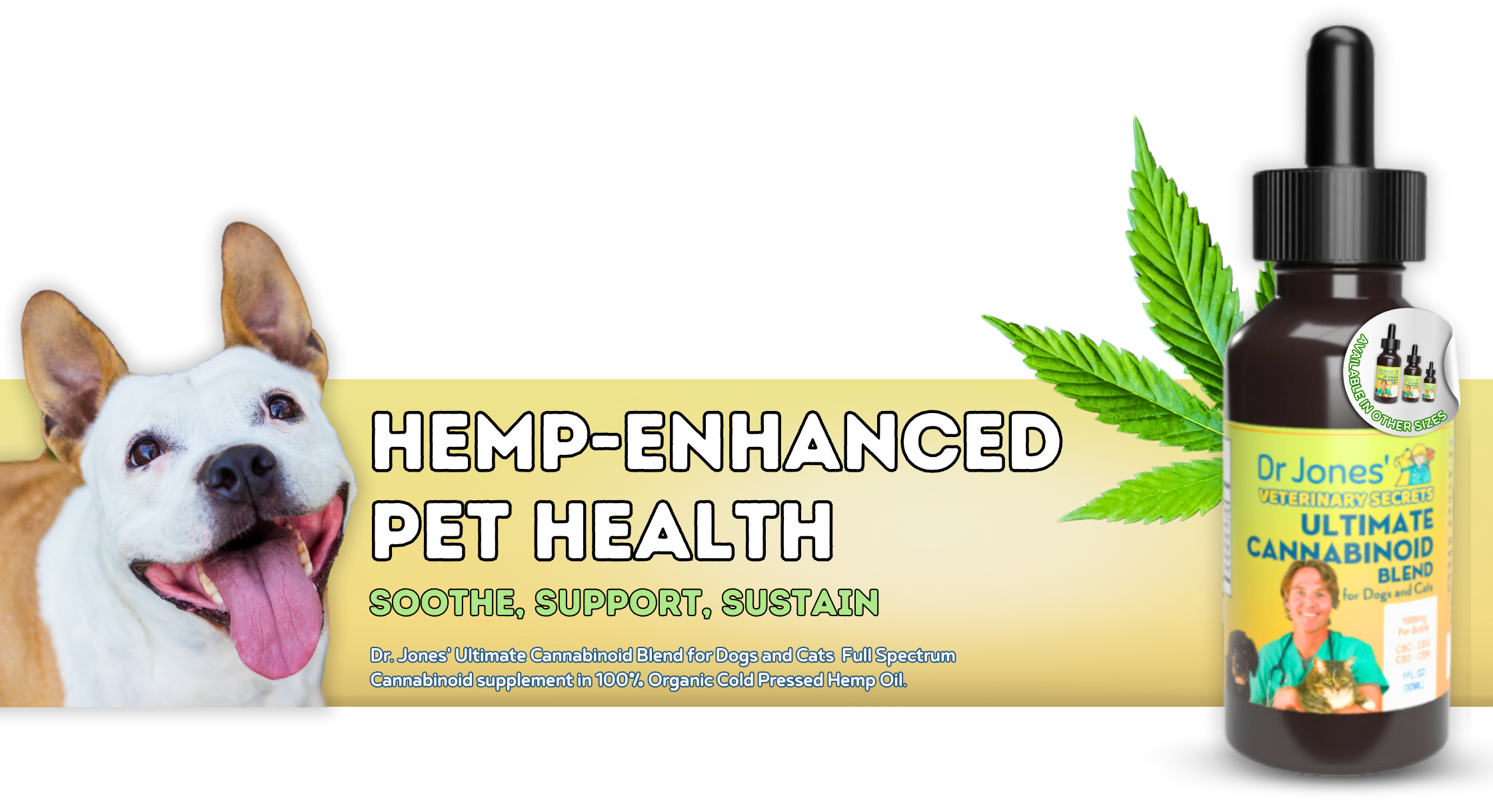Breast Cancer in Dogs and Cats: Holistic Options

I saw many animals in veterinary practice being diagnosed with mammary cancer (breast cancer), but fortunately most of the time we could do surgery to remove the cancerous masses.
It is relatively uncommon in cats, and 50% of the cases in dogs are benign. But if it is malignant, then you want to be considering your alternative options.
The cannabinoids have been extensively studied, and in many cases shown to be beneficial against the hormonal cancers, such as mammary cancer.
A cannabinoid supplement that includes CBD, but also some of the other beneficial cannabinoids such as CBC and CBG is a good idea.
We now have a multi-cannabinoid blend for dogs and cats that is NOW 15% OFF here:
Dr Jones’ ULTIMATE Cannabinoid Blend for Dogs and Cats



Understanding Mammary Tumors in Dogs and Cats
As a practicing veterinarian, I often encounter mammary tumors, especially in female dogs and, to a lesser extent, in cats. These tumors, similar to breast tumors in humans, can vary in severity and treatment outcomes. Today, I’d like to share my insights on this significant health concern.
Mammary Tumor Prevalence and Risk Factors
Mammary tumors are notably common in female dogs but are rare in male dogs and cats. The breeds most susceptible include poodles, dachshunds, and spaniels for dogs, and Siamese or other Oriental breeds and domestic shorthairs for cats. One notable risk factor in dogs is obesity at a young age.
For female dogs, the likelihood of developing mammary tumors significantly increases if they are not spayed or are spayed after 2 years of age. The risk is about 0.5% if spayed before their first heat (around 6 months old), 8% after their first heat, and 26% after their second. Conversely, cats spayed before 6 months see a 7-times reduced risk of developing mammary cancer.
Clinical Signs and Symptoms
The most common sign of a mammary tumor is a palpable mass underneath the skin of the abdomen or near a nipple, which may feel firm like a pea. Other symptoms can include discharge from a mammary gland, ulceration of the skin over a gland, painful swollen breasts, loss of appetite, weight loss, and generalized weakness.

Traditional Veterinary Treatments
The primary treatment for mammary tumors involves surgery. In dogs, this might be as simple as removing the mass or the affected mammary gland. In cats, I recommend more aggressive surgery, potentially removing one or both sets of mammary glands, usually across two operations spaced a few weeks apart. Additionally, the local lymph node should be removed if possible to check for cancer spread.
Post-surgical chemotherapy may be necessary in some cases, though the role of chemotherapy, hormonal therapy, immunotherapy, and radiation therapy in treating mammary tumors in cats and dogs is not yet clearly defined for all tumor types. I often advise consulting an oncologist after surgery.
Exploring Alternative Treatment Options
-
Melatonin for Cancer: Research supports the benefits of melatonin, a powerful antioxidant, in combating cancer. It enhances the immune system’s effectiveness against cancer and can complement traditional treatments like chemotherapy or radiation. Typical doses are 1mg per 10 pounds of body weight, up to a maximum of 6mg, given about an hour before bedtime.
-
Colostrum for Cancer: Bovine colostrum has shown promise in cancer research due to its cost-effectiveness and minimal side effects. It can significantly enhance a cancer patient’s quality of life. Recommended dosing is about 100mg per 10 pounds of body weight daily.
-
Artemisinins: Originally used as antimalarials, artemisinins have potential in treating a range of diseases, including cancer. They are well-tolerated and affordable. Consider 30mg per 10 pounds of body weight, once or twice daily.
-
Dandelion Root: This traditional remedy involves brewing a tea from ground dandelion root to help fight cancer. Use about a teaspoon per 20 pounds of body weight, simmered in a cup of water for 20-30 minutes.
-
Panacur for Cancer: The story of Joe Tippens, who recovered from cancer using fenbendazole, a common dewormer, has led to its exploration for treating pet cancers. The typical regimen involves 50mg per kg of body weight, administered three days on, four days off.
-
Medicinal Mushrooms: Turkey Tail mushrooms, used in Japan as a colorectal cancer treatment, show great promise due to their immune-boosting properties. The recommended dose is 100mg per 10 pounds daily.
-
Cannabinoids for Cancer: Cannabinoids, like CBD and CBC, inhibit cancer by affecting cell proliferation and reducing inflammation. They are effective in pain relief and help the immune system target and attack cancer cells.
Regularly checking your pets for signs of mammary tumors is crucial, especially if you detect a firm, pea-sized nodule. Early spaying can prevent many cases, but it’s important to consider other health risks associated with early spaying. If you are dealing with a pet in pain, suffering from arthritis, or battling cancer, I recommend exploring the potential benefits of medicinal cannabinoids, which are safe and may offer substantial relief.
Special Offer:
For those interested, we now offer a 15% discount on Dr. Jones’ ULTIMATE Cannabinoid Blend for Dogs and Cats, available here.
Thank you for trusting me with your pet’s health. Together, we can strive for a life of health and happiness for our furry friends.

My dog’s T4 is elevated. We have an ultra sound July 8. I’m terrified as it appears prognosis is poor for resolution if there is a tumor. I am all for quality supplements. What would you recommend?
Dog Lumps and Cat Lumps: 7 Quick And Easy Solutions
If your dog or cat has a lump, you may be relieved to know that there are a number of things that you can do at home. Most lumps are easy to feel. They may show up on the chest or along the back. Most lumps on dogs are benign, while lumps that appear on cats are often cancerous. Often while petting your pet a cyst becomes noticeable.
As your pet ages, its immune system becomes less effective and lumps and bumps become more prevalent. The immune system is always working to keep away abnormal growths. Common dog lumps are lipomas (benign fatty tumors) and sebaceous cysts (a skin gland that blocks up). Cats relatively often develop cysts, while firm, rapidly growing lumps warrant concern as being cancer.
Assess. The first thing to do is assess the severity of the lump. Lumps that are regularly shaped are less likely to be serious. Lumps that move easy under the skin are usually benign, such as fatty tumors (lipomas). Lumps that grow slowly are likely benign. Lumps that discharge a cheesy material are usually sebaceous cysts and can be left alone.
Aspiration of the mass.A simple thing to do to determine if a mass is serious is to visit your veterinarian and have him or her perform a needle aspirate and cytology of the lump. A microscopic slide can often tell if it is serious or not.
Keep Them Clean.A ruptured cyst needs to be kept clean so it will heal and not become infected. Wash it twice daily with an antiseptic solution (such as chlorhexidine or Iodine). Trim the hair around the cyst to aid in cleaning.
Compressesare a very overlooked way to treat many lumps and cysts. A cyst that is enlarged but won’t rupture can be decreased in size by applying a warm cloth directly to the area daily. Heat the cloth so it is very warm to your skin, then apply it to your pet’s skin until it cools down. Do this twice daily for at least 7 days.
Stimulate the Immune System of the Skin. Vitamin E and essential fatty acids are great for boosting your pet’s skin immune function: give 100 IU per 10 lbs of body weight daily of Vitamin E. The omega 3 fatty acids, especially fish and krill oil are excellent immune stimulants for the skin
Consider Healing Mushrooms. Certain mushrooms have immune stimulating activity. Some of these include, Turkey Tail, Reishi, Maitake. The dose is 25 mg per 10 lbs daily.
Apple Cider Vinegar (ACV). Apple cider vinegar acts as a peeling agent and removes dead skin cells and the virus found directly in the skin pores. With regular application of ACV, the warts become hard and appear black in color, and eventually should detach from the skin. Before using apple cider vinegar, first wash the affected area with a mild soap (must be clean and free from oil). Wet a cotton ball completely with ACV and put it on the affected area. Use a wrap of some kind to hold the cotton ball in place – ideally you want this on overnight. You can also just apply ACV with a swab and cover that (to prevent your pet from licking it off). If you are persistent with applying ACV, you should see a difference within a week.
There are a few specific herbs that I want you to consider. The first are the topical herbs Aloe and Calendula. They are two herbs available in a cream that will take away some of the inflammation from a ruptured cyst.
Green Tea has numerous benefits, but specifically for lumps and bumps. Green Tea has been shown toy stimulate the immune system and inhibit lump growth. Standardized green tea extract is dosed at 50 mg per 10 lbs of body weight daily. This has been very helpful for dog lipomas as it is increasing metabolism, resulting in smaller lumps.
CBD (Cannabidiol). A key use for the cannabinoids is for masses – those that are benign, and those that are potentially cancerous. In part the cannabinoids are making the immune system more effective, while at the same time being anti-inflammatory on the growth. Standard CBD doses are 3mg/10lbs twice daily. We now have an awesome CBD supplement.
95% Curcumin. This is isolated from the herb tumeric, and has specific studies showing it to be beneficial for precancerous masses. 95% curcumin doses of 50-100mg/10lbs once-twice daily.
A paper titled ‘Curcumin and Cancer’ concluded this:
“curcumin exhibits anticancer ability by targeting different cell signaling pathways including growth factors, cytokines, transcription factors, and genes modulating cellular proliferation and apoptosis”
Homeopathy.The last remedy that has helped many a dog or cat with abnormal lumps is a homeopathic called Thuja. The first homeopathic remedy that many homeopaths advise for any type of canine or feline cancer. The dose is 30C given once-twice daily for at least 30 days.
If your pet has a lump or abnormal growth, take heart in knowing that most lumps are not cancerous, and that they can be treated at home. If you are at all concerned, see your veterinarian, having the lump examined and possibly aspirated. If it is a benign mass, consider some of the above suggested home treatments.
Thank you so much, Danyll~my dog has l think , a lipoma. I very much appreciate your help!